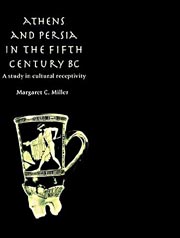Athens and Persia in the Fifth Century BC
A Study in Cultural Receptivityby Margaret Christina Miller
"...the book is a major achievement of its kind: never before have the many-faceted relations between Athenians and Persians been brought so vividly and in such detail befor our eyes. M. states in her preface that this book needed to be written, but that she had doubts whether she `should be the one to write it' (xiii); having read it, this reviewer is thoroughly convinced that M. was exactly the right person to write it." Balbina Baebler, Bryn Mawr Classical Review "...this is a major contribution towards proper social and cultural history of Classical (fifth-and fourth-century, democratic) Athens." Paul Cartledge, The International History Review "This book is a welcome addition to the study of Greek-Persian relations. It is a detailed and well-illustrated examination of the archaeological materials, supported by textual evidence, that revealPersia's heavy influence on fifth-centuryAthens." Journal of Near Eastern Studies "...admirably thorough and comprehensive....the book is a major achievement and a model of its kind: never before have the many-faceted relations between Athenians and Persians been brought so vividly and in such detail before our eyes." Balbina Baebler, Bryn Mawr Classical Review "Any serious student of classical Athens should read it.... ...Miller's book is the start of an important debate." Christopher Tuplin, Letters inCanada "All who read this thought-provoking book will find their understanding of fifth-century Athens greatly enriched, and come to realize that her extraordinary achievements are predicated on intimate contact with thePersian Empire." Amélie Kuhrt,Phoenix
This is the first comprehensive collection of evidence pertaining to the relations betweenAthens and Persia in the fifth century BC. Archaeology, epigraphy, iconography and literature all reveal some facet of Athenian receptivity to Persian culture. This innovative and fully illustrated study traces the Athenian response as it appears in pot shapes, clothing, luxurious display and monumental architecture. Even while despising the Persians, the Athenians appropriated and reshaped aspects of Achaemenid culture to their own needs.
Herodotus and Religion in the Persian Warsby Jon D. MikalsonJon Mikalson's book will surely prove an invaluable resource for any student working in the area of Herodotus, Greek religion, or the Persian War period. Rigorous in the standards it applies to the study of this complex subject, it makes a fine addition to the oeuvre of a leading exponent of Greek religion.(Robert Garland, Colgate University)
The two great Persian invasions of Greece, in 490 and 480-79 B.C., both repulsed by the Greeks, provide our best opportunity for understanding the interplay of religion and history in ancient Greece on a large scale. Using theHistories of Herodotus as well as other historical and archaeological sources, Jon Mikalson shows how the Greeks practiced their religion at this pivotal moment in their history.
In the period of the invasions and the years immediately afterward, the Greeks--internationally, state by state, and sometimes individually--turned to their deities, using religious practices to influence, understand, and commemorate events that were threatening their very existence. Greeks prayed and sacrificed; made and fulfilled vows to the gods; consulted oracles; interpreted omens and dreams; created cults, sanctuaries, and festivals; and offered dozens of dedications to their gods and heroes--all in relation to known historical events.
By portraying the human situations and historical circumstances in which Greeks practiced their religion, Mikalson advances our knowledge of the role of religion in fifth-centuryGreece and reveals a religious dimension of the Persian Wars that has been heretofore overlooked.
Early Mongol Rule in Thirteenth-Century IranA Persian Renaissanceby George LaneAn account of the re-emergence of Persia as a world player and the reassertion of its cultural, political and spiritual links with Turan, this book opposes the way in which, for too long, the whole period of Mongol domination ofIran has been viewed from a negative standpoint. Though arguably the initial irruption of the Mongols brought little comfort to those in its path, this is not the case with the second 'invasion' of the Chinggisids. This study demonstrates that Hülegü Khan came as a welcomed king rather than as a conqueror. It paints a picture of the early Il-Khanate as a cultural and spiritual renaissance and reveals both Hülegü and his son Abaqa as fathers of that legacy.